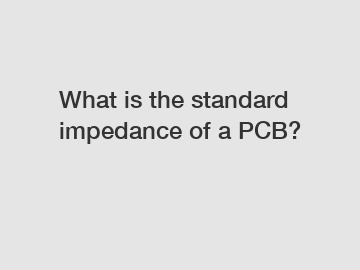What is the standard impedance of a PCB?
What is the standard impedance of a PCB?
As the world becomes increasingly connected, with technological advancements enabling faster and more efficient data transfer, the standard impedance of a printed circuit board (PCB) plays a crucial role in ensuring optimal signal integrity. But what exactly is the standard impedance of a PCB, and why is it so important? Let's delve into this topic and explore its various aspects.
1. Understanding Impedance:

Impedance can be described as the measurement of opposition to the flow of an electrical current in a circuit. It encompasses both resistance and reactance and is typically measured in ohms. An impedance mismatch in a PCB can lead to signal reflections, resulting in poor performance and potential data loss.
2. Why is Impedance Important in PCB Design?
To address the ever-increasing demand for high-speed digital and analog circuits, PCB designers need to ensure that the impedance of their circuits remains within standard values throughout the entire PCB layout. Maintaining a consistent impedance allows for proper signal propagation without distortion or loss, ensuring reliable communication between electronic components.
3. Standard Impedance Values:
The standard impedance of a PCB heavily depends on the specific application and the transmission line technology being employed. Typically, a characteristic impedance of 50 or 75 ohms is considered standard for PCBs. This value is widely used in applications such as telecommunications, networking, and high-speed data transfer.
4. Factors Influencing Impedance:
Several factors impact the standard impedance value of a PCB. One crucial factor is the dielectric constant (or relative permittivity) of the substrate material used in the PCB. Different materials possess varying dielectric constants, which directly affect the propagation of electrical signals. Moreover, the thickness and the geometry of the transmission lines and their proximity to other components and traces also influence the PCB's impedance.
5. Design Considerations:
To achieve the desired impedance in a PCB design, there are certain design considerations to keep in mind. Firstly, choosing a substrate material with a known and consistent dielectric constant is crucial. Popular choices include FR4 and Rogers materials due to their stable and predictable characteristics. Secondly, precise control of trace width and spacing is necessary to achieve the desired impedance. Utilizing impedance calculators and simulation tools can aid in achieving accurate trace dimensions.
6. Impedance Control Techniques:
To maintain impedance consistency, there are several techniques that PCB designers employ. One common approach is controlled impedance routing, which involves matching trace widths and spacing to achieve the desired impedance level. Another technique is the use of differential pairs for high-speed signaling, where the impedance between the two traces is tightly controlled. These techniques ensure that the impedance is maintained within acceptable limits.
7. Signal Integrity Challenges:
Failure to meet standard impedance values in PCB design can result in signal integrity issues. Impedance mismatches can cause signal reflections that result in signal degradation, leading to data errors or even complete signal loss. This may result in decreased system performance, increased electromagnetic interference, and increased power consumption. Therefore, adhering to standard impedance values is essential to ensure successful PCB performance.
In conclusion, the standard impedance of a PCB is a critical consideration in ensuring reliable signal transmission and maintaining signal integrity. PCB designers must carefully consider and control impedance to achieve optimal performance in high-speed digital and analog circuits. Factors such as dielectric constant, trace dimensions, and substrate material selection play pivotal roles in determining the impedance values. By adhering to standard values and employing impedance control techniques, designers can overcome signal integrity challenges and achieve efficient and error-free communication in modern electronic systems.
Are you interested in learning more about immersion tin 4layer , Industrial Control PCB Manufacturer, hasl lead free? Contact us today to secure an expert consultation!

Comments